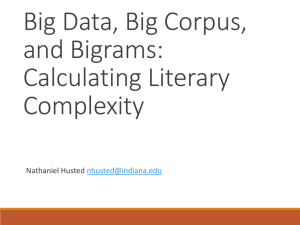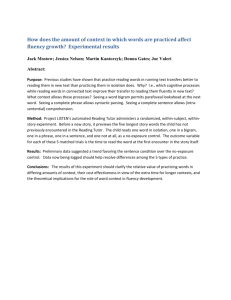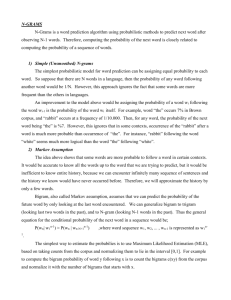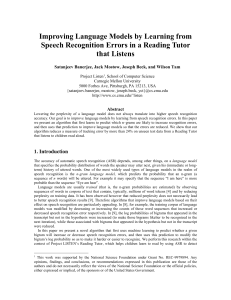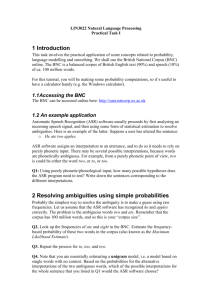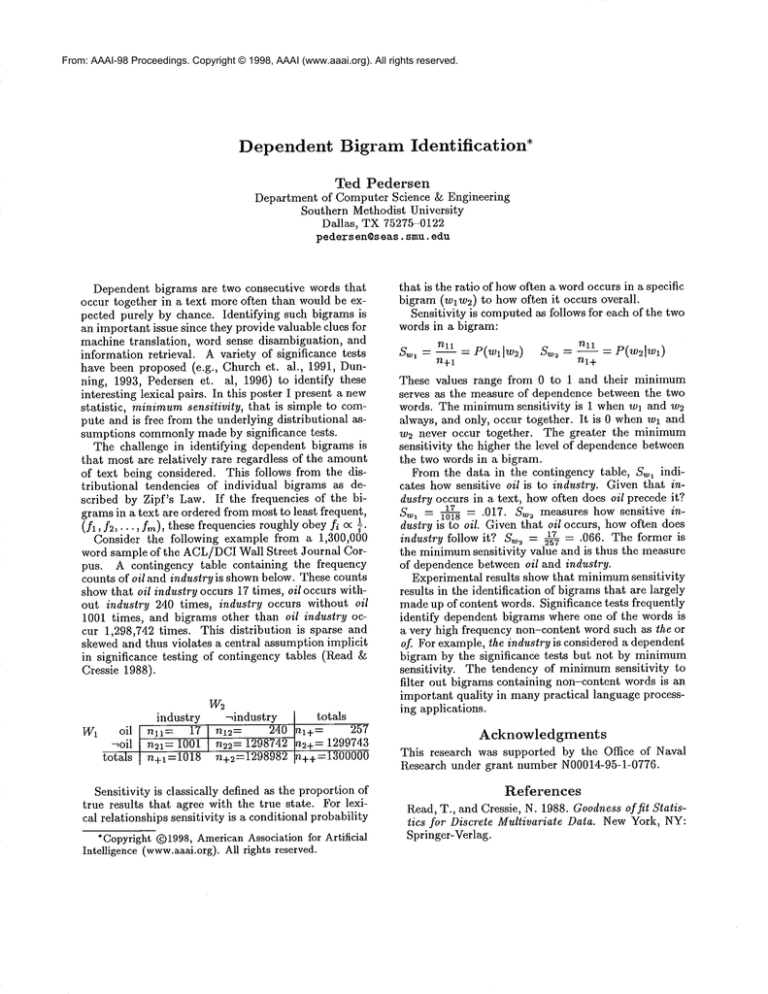
From: AAAI-98 Proceedings. Copyright © 1998, AAAI (www.aaai.org). All rights reserved.
Dependent
Bigram Identification*
Ted Pedersen
Department of Computer Science & Engineering
Southern Methodist University
Dallas, TX 75275-0122
pedersen~seas,
smu.edu
Dependent bigrams are two consecutive words that
occur together in a text more often than wouldbe expected purely by chance. Identifying such bigrams is
an important issue since they provide valuable clues for
machine translation, word sense disambiguation, and
information retrieval. A variety of significance tests
have been proposed (e.g., Church et. al., 1991, Dunning, 1993, Pedersen et. al, 1996) to identify these
interesting lexical pairs. In this poster I present a new
statistic, minimumsensitivity, that is simple to compute and is free from the underlying distributional assumptions commonlymade by significance tests.
The challenge in identifying dependent bigrams is
that most are relatively rare regardless of the amount
of text being considered. This follows from the distributional tendencies of individual bigrams as described by Zipf’s Law. If the frequencies of the bigrams in a text are ordered from most to least frequent,
(fl, f~, ..., f,,), these frequenciesroughlyobey fi oc
Consider the following example from a 1,300,000
word sample of the ACL/DCIWall Street Journal Corpus. A contingency table containing the frequency
counts of oil and industry is shownbelow. These counts
showthat oil industry occurs 17 times, oil occurs without industry 240 times, industry occurs without oil
1001 times, and bigrams other than oil industry occur 1,298,742 times. This distribution is sparse and
skewedand thus violates a central assumption implicit
in significance testing of contingency tables (l~ead
Cressie 1988).
W2
industry
--industry
| totals
257
oil Inn-- 17 I n12=
240 In1+-~oil n21= 1001 n2~= 1298742 Ins+= 1299743
totals
n+1=1018 n+2=1298982 tn++=1300000
Sensitivity is classically defined as the proportion of
true results that agree with the true state. For lexical relationships sensitivity is a conditional probability
*Copyright(~)1998, AmericanAssociationfor Artificial
Intelligence (www.aa~i.org).
All rights reserved.
that is the ratio of howoften a wordoccurs in a specific
bigram (WlW2)to howoften it occurs overall.
Sensitivity is computedas follows for each of the two
words in a bigram:
Sw, = rill = p(wliW2) Sw2 -- nl~l -- P(w2]Wl)
n+l
nl+
These values range from 0 to 1 and their minimum
serves as the measure of dependence between the two
words. The minimumsensitivity is 1 when Wl and w2
always, and only, occur together. It is 0 whenWl and
w~ never occur together. The greater the minimum
sensitivity the higher the level of dependencebetween
the two words in a bigram.
Fromthe data in the contingency table, S, ol indicates howsensitive oil is to industry. Given that industry occurs in a text, howoften does oil precede it?
17
.017. S~2 measures how sensitive inS~1 - 1018dustry is to oil. Given that oil occurs, howoften does
industry follow it? S,v~ = 2~7 = .066. The former is
the minimumsensitivity value and is thus the measure
of dependence between oil and industry.
Experimental results show that minimumsensitivity
results in the identification of bigramsthat are largely
madeup of content words. Significance tests frequently
identify dependent bigrams where one of the words is
a very high frequency non-content word such as the or
of. For example, the industry is considered a dependent
bigram by the significance tests but not by minimum
sensitivity. The tendency of minimumsensitivity to
filter out bigrams containing non-content words is an
important quality in manypractical language processing applications.
Acknowledgments
This research was supported by the Office of Naval
Research under grant number N00014-95-1-0776.
References
l~ead, T., and Cressie, N. 1988. Goodnessoffit Statistics for Discrete Multivariate Data. NewYork, NY:
Springer-Verlag.

